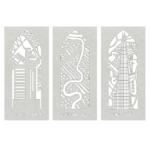LFA Competition Shortlist: Tooley Street Triangle
make:good were recently shortlisted for a competition run by the London Festival of Architecture and Team London Bridge to design an intervention for an unloved corner of pavement opposite the Tooley St London Bridge Underground exit. The brief called for:
“a design concept that will use visual clues and public realm infrastructure to transform the ability and desire to stop, enjoy and make decisions at this site”
so we thought why not? That’s what we do; use small interactions to bring joy, pleasure and a smile to underused places. So we set to work!
It might be obvious, but as “an architecture & design studio involving people in shaping neighbourhood change”, it’s important to us to design with local people. What’s also important though, is that whatever design we put into a project is informed and guided by the place itself. So as soon as we started working on Tooley St, we looked into the history and stories of the area.
And stories there were! The famous “Old London Bridge”, (yes the one in the nursery rhyme!) was actually about 40 metres downstream from the current one, meaning it would have landed close to the competition site. This made sense, as the concrete building that backs onto the pavement here is called Colechurch House, after Peter of Colechurch who designed the first stone bridge across the Thames here. To be fair to him, it wasn’t his fault most people now know it as “falling down” – it did last 800 years after his death!
Now the thing we found really interesting was the part of Peter’s designs that featured a chapel, right in the middle of the bridge, in a specially built, extra-wide and -long bridge support. A full chapel, with 5 gothic arch windows on each side, a vaulted ceiling and crypt below! In the rushing waters of the medieval Thames.
Given the competition was asking us to create a place of quiet, a place to stop and reflect and enjoy a space in the busy rush of London Bridge station, it seemed not only fair, but poetic and important to memorialise this oddity of London history, lost to the waters of time. To bring back a forgotten story.
Our idea was to bring back a memory of this lost landmark of London Bridge, but in a new form that caught and pleased the eye as well as linking to the landmarks of modern London. Our structure, which we called ‘The Orange Folly’ pays homage to the the sense of peace and elegant form of the chapel in a secular, contemporary manner.
By working with local schoolchildren and interest groups, we planned to co-design silhouette “windows” as part of the proposed folly, each of which would have featured and directed people to one of the area’s attractions – Borough Market, HMS Belfast, City Hall – with pattern and form based on old maps and historical fragments of the area.
The main reason that the LFA and TLB wanted proposals for this space was to help direct people to the many attractions of the area – if you’ve ever come out of that particular tube exit, you’ll know you can’t see any of them! The scheme was not only to direct people, but to direct them to cleaner, less congested and polluted routes, as part of the Low Emission Neighbourhood scheme. The proposal included an option to extend the wayfinding capacity by using the vaulted window designs to act as arrows rendered in thermoplastic floor graphics.
As well as suggesting hops plants to grow up the structure, another reminder of this area’s beer-linked past, we thought a good addition would be a bench to sit and pause on. We designing a gabion cage surrounding the base of the already on-site tree, for which we would have gathered the stones with the local children from the banks of the Thames, maybe even managing to find some fragments of the old bridge our ideas were based on.
That’s the thing – we like to tell stories. We work with people to bring their input, their stories to the public realm. By combining threads from what a place was, and who lives there now, we often find the resulting stories, narratives and designs are far stronger for those connections.
When presenting our competition entry at LFA’s public event, the main question we were asked from the floor was: “How did you find out this amazing story about this area?” This threw into sharp relief how we do what we do and why it works.
To answer that question:
“We find the stories because it makes people smile to hear them.”
On this occasion LFA went with Charles Holland‘s design but it was great to be shortlisted and to meet the other teams. You can see all of the entries, including the winner here.







